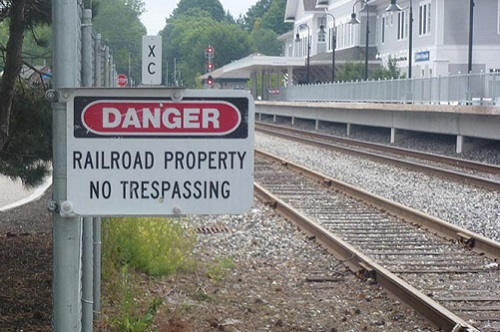Demographic and Environmental Characteristics of Rail Suicides
 For decades, initiatives have been proposed and implemented to keep communities safe near railroad rights-of-way. Still, trespassing leads to hundreds of injuries and fatalities each year at grade crossings or on rights-of-way.
For decades, initiatives have been proposed and implemented to keep communities safe near railroad rights-of-way. Still, trespassing leads to hundreds of injuries and fatalities each year at grade crossings or on rights-of-way.
These statistics include people who want to harm themselves.
For the Federal Railroad Administration (FRA), rail operators, and communities to reduce rail suicides, they need to comprehensively understand the characteristics of such incidents.
The U.S. DOT Volpe Center analyzed FRA data to produce a baseline measure of rail trespassing and suicide incidents. This baseline is the foundation for a broader understanding of these incidents in the U.S., and for potential best practices to mitigate these incidents.
Current Status
Volpe collected and examined FRA trespassing incident reports involving pedestrians, covering 2012 to 2014. FRA is reviewing a draft technical report. The technical report used data from these sources:
- The Railroad Injury and Illness Summary and Continuation Sheet (FRA Forms F 6180.55 and 6180.55a)
- Highway-Rail Grade Crossing Accident/Incident Report (Form 6180.57)
Preliminary Findings
There are several notable preliminary findings:
- Consistent with national suicide trends, fatal rail suicide incidents involve men more often than women.
- Faster-moving trains were generally more lethal than slower trains, but there were still several injuries involving trains traveling over 60 miles per hour, and fatalities involving trains traveling under 15 miles per hour.
- Fatal incidents—intentional and unintentional—at pedestrian grade crossings take place during clear weather conditions and moderate temperatures, between 60° and 74° F.
- Incidents involve freight trains more often than passenger trains.
- National data show that most suicide victims (by any means) are over age 45. Rail suicide victims trend younger, under age 45.
- Rail suicide incidents peak in the spring, mirroring national suicide trends.
- There are more fatal suicide incidents during periods of increased passenger train frequency, such as during a typical evening commute from 4:00 to 8:00 p.m.
Proposed Next Steps
There are two major next steps in this research:
- Update demographic data every few years. This will allow for reliable existing trends from the 2012–2014 data and will reveal changes in trends. Updating the data will also give researchers the opportunity to rigorously analyze the data with larger sample sizes.
- Volpe will examine individual factors to better understand if these data can predict incidents. Additional sources, such as more detailed data from individual railroads, other agencies, and media reports, may provide a more complete picture of incidents and provide insight toward creating best practices for developing mitigation strategies.
Relevant Research
The following FRA reports review known characteristics of victims of rail trespass and suicide in the U.S.:
- Characteristics of Trespassing Incidents in the United States, 2012-2014 (FRA/Volpe, 2018)
View publication - Defining Characteristics of Intentional Fatalities on Railway Rights-of-Way in the United States, 2007-2010 (FRA/Volpe, 2013)
View publication - Demographic Profile of Intentional Fatalities on Railroad Rights-of-Way in the United States (FRA/Volpe, 2013)
View publication
Below is a selection of international publications from groups that have done work in this area:
- Main Characteristics of Train-Pedestrian Fatalities on Finnish Railroads (2012)
View publication - Trespassing on Finnish Railways: Identification of Problem Sites and Characteristics of Trespassing Behavior (2009)
View publication - Railways and Metro Suicides: Understanding the Problem and Prevention Potential (2007)
View publication - Suicide in the Montreal Subway System: Characteristics of the Victims, Antecedents, and Implications for Prevention (1999)
View publication
National Suicide Prevention
If you or someone you know are in crisis or need to talk, please call the 988 Suicide & Crisis Lifeline anytime, 24 hours a day, 7 days a week, at 988 or visit https://988lifeline.org/.
Related Pages: 6 Key Research Areas
- Suicide Countermeasure Pilot Projects
- Media Reporting of Trespass and Suicide Incidents
- Global Railway Alliance for Suicide Prevention (GRASP)
- Trespasser Intent Determination
- Demographic and Environmental Characteristics of Rail Suicides
- GIS Mapping of Rail Trespass and Suicide
Return to the main Rail Suicide Prevention Resource Page.
